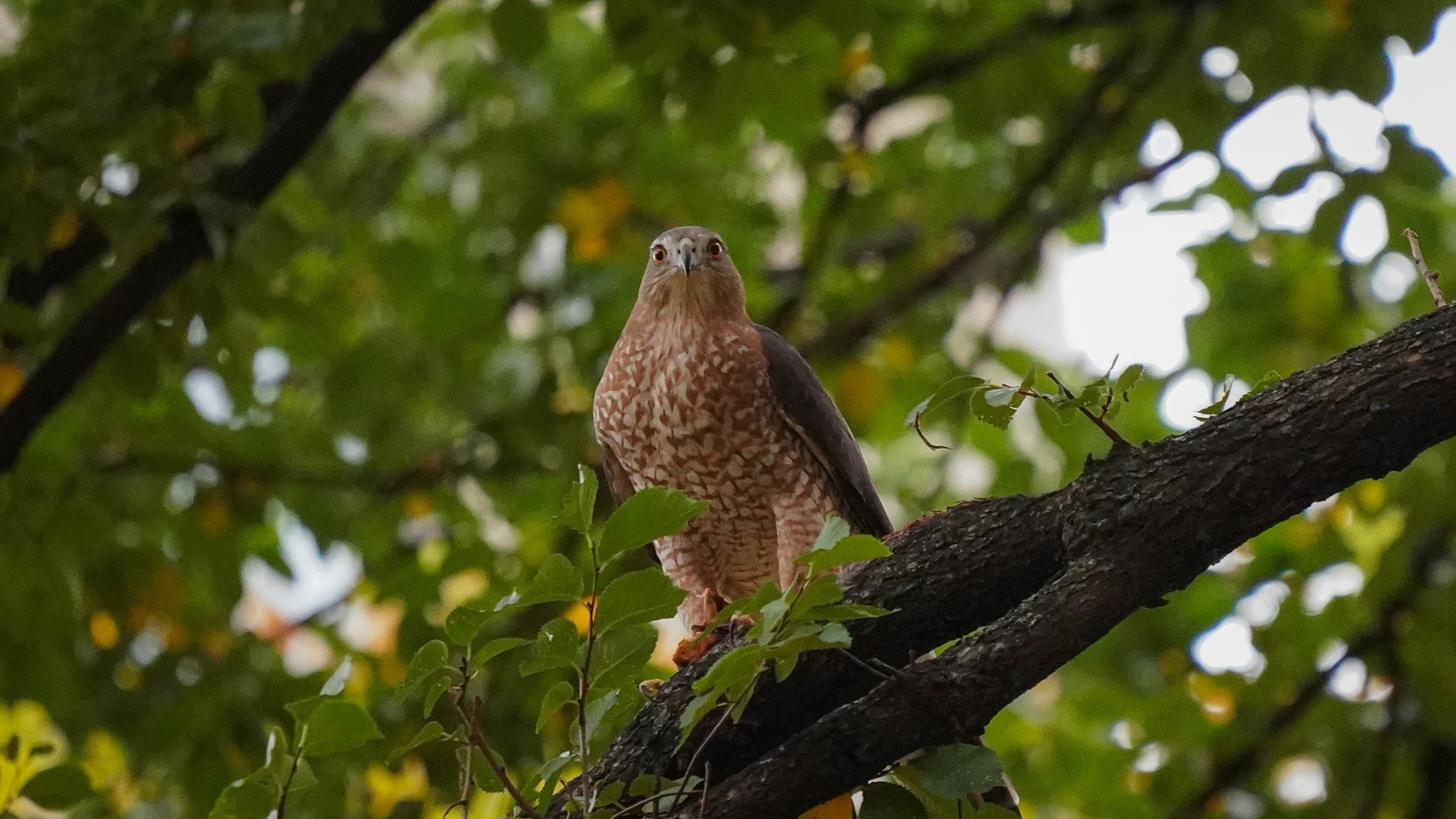This site uses cookies – Learn more.
Wildlife: A Cooper’s Hawk Hunt
Wildlife: A Cooper’s Hawk Hunt

Cooper’s Hawk (Accipiter cooperii)
It seems like not too long ago, spring was just beginning to sprout from the frozen winter earth. Now, at the tail end of the fall season, cutbacks and fallen leaves have slowly removed any semblance of the previous spring and summer. These dormant treetops and a swelling wildlife population have created a unique habitat here at Madison Square Park.
Less foliage to shelter the birds, squirrels, mice, and bats at the Park, means these creatures take on a greater risk when foraging for food or nesting materials. For predators, these conditions provide an advantage that could be crucial to their own survival, but with a hunting success rate at only ~27%, Cooper’s Hawks face a challenging winter ahead of them.
An “attacking” raptor
Birds of prey, or raptors, are divided into two groups based on their hunting behavior. Cooper’s Hawks, like the rest of the genus of accipiters, are considered “attacking” raptors. These raptors concentrate hunting efforts on relatively large, less numerous, more agile prey. They spend less time perched searching for prey, and their attack is often complex, energy-demanding, and sometimes prolonged. Raptors like the Cooper’s Hawk are better “attackers” than they are “searchers” so they prefer the more demanding method. This presents them a few challenges.
The size of prey taken by “attacking” raptors is relatively heavy averaging 25 to 50% of the body weights of the raptors. Another challenge is that birds–the most agile prey group–makes up 56% of their hunted prey. Because of this, their hunts are often at high speeds and exhaust a lot of valuable energy. Although Cooper’s Hawks have developed short, rounded wings and long, rudder-like tails, to allow them to skillfully maneuver among trees and underbrush, dashing through vegetation to catch birds is a dangerous lifestyle. In a study of more than 300 Cooper’s Hawk skeletons, 23 percent showed old, healed-over fractures in the bones of the chest! One could say that Cooper’s Hawks almost prefer the thrill of the hunt.
Challenges of the urban setting
Although an abundance of less agile prey like pigeons might present an important advantage, hunting in urban settings presents a number of additional challenges for the Cooper’s Hawk.
Urban parks like Madison Square Park are small and isolated relative to the vast forests of rural New York. This means less shelter and more difficulty escaping to larger forested areas. This also means less opportunity to find mates and a smaller territory to hunt and nest.
The size of these territories also means more energy has to be used defending it from other raptors. Two raptors cannot coexist at Madison Square Park, and larger birds of prey like Red-tailed Hawks tend to overpower the smaller Cooper’s Hawk.
Another challenge is human perception. Because of their aggressive hunting behaviors, Cooper’s Hawks have become villainized by society. American Ornithologist A.C. Bent once wrote of the Cooper’s Hawk, “If the sharp-shinned hawk is a blood-thirsty villain, this larger edition of feathered ferocity is a worse villain, for its greater size and strength enable it to do more damage.” This perception meant that for years, these birds were hunted down in cities and towns around the country. For Cooper’s Hawks, this created an aversion to towns and cities, but now, they are once again fairly common urban birds thanks in part to “let wild animals be wild” initiatives. Some studies show their numbers are actually higher in towns than in their natural habitat, forests.
At Madison Square Park, we welcome these animals as a sign of a healthy ecological food chain. To think that one of the planet’s most skilled fliers showcases their aerial abilities in the heart of the city is an amazing reality. One certainty is that aspects of nature will always adapt and prosper despite whatever harm the planet suffers through. A Cooper’s Hawk swooping for its prey meters from the morning yoga classes is just another example of this perseverance. So next time you are in the park and a flock of birds have been startled from their perches, keep an eye on the open sky for the flashing movements of a Cooper’s Hawk.
To learn more about the birds and other flora and fauna throughout Madison Square Park, visit eBird and iNaturalist, or read more about our ongoing initiative to support our local wildlife.



